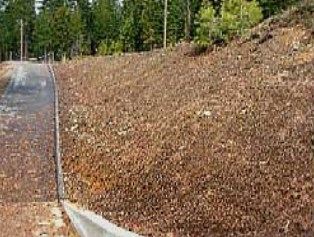Erosion Control Toolbox: Soil Rehabilitation
Introduction


Compacted soils that are low in organic material and nutrients may lead to impaired plant health, limited plant growth, and non-sustainable vegetative cover, which may result in erosion and water quality problems.
The topics below identify key considerations in the design of sustainable, long-term vegetative cover.
Problem Soils
Early identification of problem soils on a project site during the PID or PA&ED phase may alert the project development team of the need to budget for appropriate stormwater quality and erosion control measures. Typical problem soils found on Caltrans projects include decomposed granite, serpentine, sandstone, sand, silt and clay. It’s important to understand which problem soils are prevalent in your District, which have contributed to slope failures and sediment run-off, and which erosion control treatments have been successful. The following video presents some key considerations to identify and work with problem soils for successful erosion and sediment control solutions.
Click here to watch a short video about Problem Soils
Hydrologic Soil Groups
Hydrologic soil groups (HSGs) are classified as A, B, C and D and are defined by the minimum rate of water infiltration, primarily under saturated conditions. Identifying soil groups provides the designer a better understanding of the infiltration and run-off characteristics of the project’s soils, which supports development of a sound strategy to achieve slope stability and revegetation. Generally, Group C soils are best to work with on construction sites. Comprised of clay loams and sandy clay loams, they tend to clump well which promotes slope stability. Group C soils are considered some of the best to provide adequate infiltration with low run-off, and are good at holding nutrients and water to promote vegetation. Groups A, B, and D often require amendments and in some cases geotechnical stabilization for stability and revegetation. The following video presents some key considerations to identify and work with hydrologic soil groups for successful erosion and sediment control solutions.
Click here to watch a short video about Hydrologic Soil Groups
Soil Amendments
Identification of proper quantities of soil amendments and fertilizer to ensure long-term sustainable erosion control is necessary. All sites have a minimum threshold level of nutrients that must be present for vegetation to establish and become self-sustaining. These nutrient levels can be restored by implementing a variety of treatments, including amending topsoil, and applying mulch, compost and fertilizer. The process for developing a nutrient prescription typically follows the sequence below:
- Test Total Nitrogen Level - for reference and project site soils
- Identify nitrogen deficiency in project site soils
- Determine nitrogen content and release rates of proposed amendments
- Compost, Organic Fertilizer, and Commercial Fertilizer
- Calculate application rates of compost and organic fertilizer required to meet minimum threshold requirements
- Fill-out amendment application rates in project specifications
Test Project Site Nutrient Levels
Soils should be tested as part of the project report and environmental documentation phase of work. Performing soils tests early allows the designer to recommend soil amendments to be included in the bid package for the Contractor.
Identifying Threshold Nutrient Levels
Identifying the threshold nutrient level (typically nitrogen only) for a project site is documented in the FHWA publication linked below. Follow this guidance to ensure sustainable vegetative cover that maintains water quality.
- Technical Report, Roadside Revegetation, Chapter 5 Implementation, Section 5.2 Soil and Site Treatments
- David Steinfield, Scott Riley, Kim Wilkinson, Thomas D. Landis, Lee Riley, et al. 2017. "Roadside Revegetation: An Integrated Approach to Establishing Native Plants and Pollinator Habitat"
Calculating Nutrient Application Rates
Calculating nutrient application rates (typically nitrogen only) for a project site is documented in the publications linked below. Follow this guidance to ensure sustainable vegetative cover that maintains water quality.
- David Steinfield, Scott Riley, Kim Wilkinson, Thomas D. Landis, Lee Riley, et al. 2017. "Roadside Revegetation: An Integrated Approach to Establishing Native Plants and Pollinator Habitat"
- Technical Report, Roadside Revegetation, Chapter 5 Implementation, Section 5.2.1 Fertilizers
Specifications
Amendments may be added to a project site by using any one or combination of the following erosion control treatments:
References
- Can't perform a soils test? Check out the online USDA Natural Resources Conservation Service (NRCS) Web Soil Survey
- US Forest Service, Ecological Subregions Map of California
- David Steinfield, Scott Riley, Kim Wilkinson, Thomas D. Landis, Lee Riley, et al. 2017. "Roadside Revegetation: An Integrated Approach to Establishing Native Plants and Pollinator Habitat"
Updated: November 27, 2018

